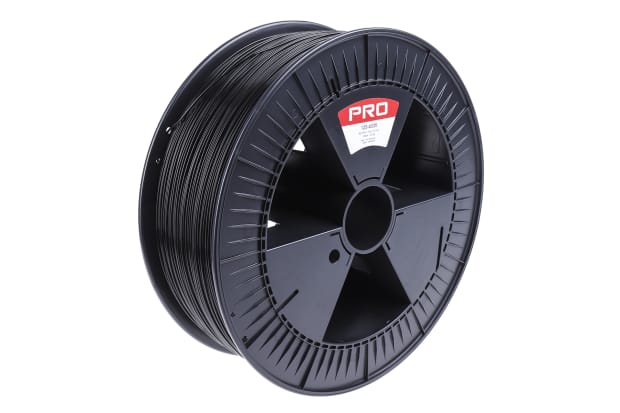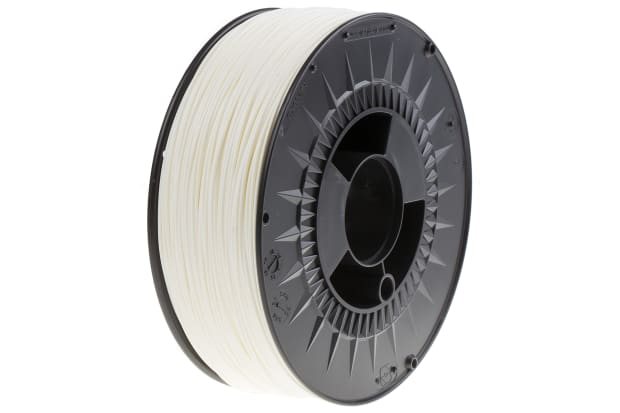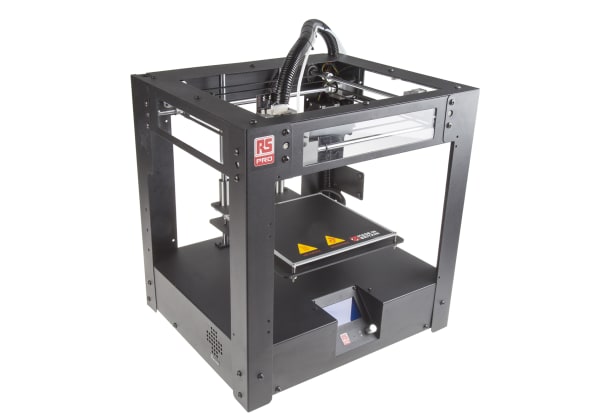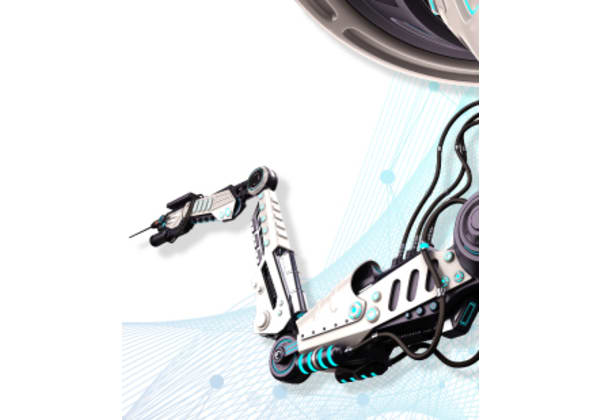- Published 18 Apr 2023
- Last Modified 29 Aug 2023
- 6 min
Filament Types for 3D Printers
Discover the essentials about the different filament types for 3D printers, including the best applications for different materials.

3D printing is now a trusted, legitimate means of fabrication with many industrial applications, whether it’s quick, accurate modelling and prototyping, or the construction of fully usable, robust components in every branch of engineering imaginable.
There still remains a wide choice of filaments, however, and each comes with its set of strengths and weaknesses. That’s what we’ll be looking at here.
What is a Filament in 3D Printing?
A filament is a thermoplastic, which means a substance that becomes liquid when it is heated, but sets into a solid when it cools. In 3D printing, they come in long strands on a spool, which can be fed into the 3D printer, where it is heated and deposited onto the print bed and then onto subsequent layers of filament, forming a three-dimensional shape.
3D Printer Filament Types
Just as there are many different kinds of plastic, each with its own properties, so there is a range of filaments available to 3D print with. The various materials come with their own temperature tolerances, chemical reactivity, solubility in various fluids, safety for food storage and preparation, and other such properties.

PLA Filament
What is PLA Filament?
PLA is short for polylactic acid, and it’s been the standard plastic used in 3D printing since the inception of the technology. Indeed, many off-the-shelf 3D printers are designed specifically to be used with PLA. It is by far the most popular filament on sale at the moment.
3D printer PLA filament has decent strength for most everyday purposes, such as models, demonstration designs for objects that will be machined or cast in real life, general household objects and such like. As it’s cheap, it is also useful for teaching and learning the art of 3D printing, and sizing prototypes for objects that will be 3D printed using other, more specialist, materials.
The material is well-loved because it is available in a whole range of colours, whether that’s standard plastic colours or specialist effects like metallic, wood, fluorescent or clear 3D printer filament.
Its main drawback, in terms of its regular use, is that it can be brittle once hardened, and can shatter if dropped or snap if flexed too much. However, if this weakness is taken into account when choosing a filament and care is taken in design and use, it is rarely a problem.
What is PLA Filament Made of?
PLA filament is made of polylactic acid, also known as polylactide. It’s a plastic that’s made from lactic acid, a product of milk, although industrially, it’s artificially synthesised.
How Long is 1kg of PLA Filament?
The length of PLA per kilogram depends on its diameter and density, but as a guide, 1kg of 1.75mm diameter PLA would be around 300 metres in length, and 1kg of 2.85mm diameter PLA would be about 120 metres long.

ABS Filament
What is ABS Filament?
ABS stands for acrylonitrile butadiene styrene, and it’s the second most popular type of filament material. You have probably handled plenty of ABS in your life because it’s the plastic that Lego bricks are made from. You’ll therefore recognise it as a tough material when engineered well, but also that it isn’t indestructible under certain conditions, particularly being twisted, crushed or being put under stress against its optimally engineered form.
ABS Filament vs PLA
ABS and PLA are pretty similar in terms of strength and cost, although ABS is generally considered the superior of the two in terms of strength, durability and precision of manufacture, especially in the ability to make sharper corners. However, ABS does require higher nozzle and print bed temperatures, and ABS is prone to warping when it cools, which is something PLA doesn’t do. In short, it’s a little more specialist and requires more expertise to work with. Although ABS is tougher, toughness isn’t always a requirement, especially when it comes at the expense of ease of printing.

PETG Filament
What is PETG Filament?
Polyethylene terephthalate (PET) is extremely common as a plastic in all sorts of applications, but it’s difficult to use with 3D printing. However, a new development is PETG, where the G stands for glycol-modified, and this is proving to be a breakthrough 3D printing filament, with growing popularity.
How to Use PETG Filament
In general, you’ll use PETG in the same way as PLA, albeit with slightly higher nozzle and bed temperatures, as per the manufacturer’s recommendations.
PETG Filament vs PLA
Both PETG and PLA are cheap and easy to use, with similar temperature ranges used (although PETG’s optimum temperature is slightly higher). The big difference is in flexibility – PETG is rather flexible compared to PLA, so has more real-world applications other than prototyping and modelmaking.
TPE Filament
Look closely at the name “thermoplastic elastomers” (TPE) and you’ll see that it’s a material with a good deal of flexibility and elasticity. You almost certainly won’t break a TPE model if you drop it, but nor will it be suitable for self-standing, intricately detailed models, as gravity will make it sag. It can be tricky to print but is excellent for soft components like mats, protective cases or washers.
Nylon Filament
Nylon is one of the oldest plastics, pioneered in the 1920s, and it remains an important fabric in all sorts of applications, from fishing lines to tough fabrication components like screws. Nylon 3D printer filament requires higher nozzle and bed temperatures than PLA which not all tabletop printers can handle, but the result is a tough, flexible and resilient plastic. One interesting feature is that it can be dyed before or after printing.
Polycarbonate Filament
Polycarbonate 3D printer filament (PC) is a very strong material, able to withstand impacts and also temperatures above 100 °C, making it ideal for safety equipment and any other application where it will be exposed to stress. It does require incredibly high nozzle temperatures, however, around the 300 °C mark.
3D Printer Wood Filament
You can achieve a relatively realistic wood effect with 3D printer wood filament, which is essentially PLA impregnated with wood fibre. It looks surprisingly realistic, partly down to the layering resembling grain, although it should only be used for display, not structurally, and definitely shouldn’t be tossed on the fire!
Metal Filament 3D Printer
Similar to wood above, metal filament is simply PLA mixed with metal powder to give a metallic finish to your models. It’s available in copper, silver, brass and other shades, and does have a dull metallic finish, rather like pewter, aluminium or aged brass.
Best 3D Printer Filament
So which is the best filament? It depends on aesthetics, ease of use, load-bearing requirements, flexibility, cost and a host of other factors. At the moment, PLA is considered the best all-rounder because it’s cheap, easy to work with and gives reasonably strong and precise finished products. You’d never make jet engine fan blades out of PLA, but that’s not what regular people use <u>3D printing</u> for – it’s still largely a prototyping and display medium.
Most Flexible 3D Printer Filament
If flexibility is important, TPE wins by some distance. Its finished product has a rubbery, flexible and stretchable form, which makes it practically unbreakable unless it’s cut or greatly overstretched.
Strongest 3D Printer Filament
If strength is important, stick with polycarbonate, as it’s about as strong as you can get with 3D-printed plastic. If you’re using a regular consumer 3D printer, however, it’s likely that it won’t be set up to print PC, so it might be time for an upgrade to your <u>3D printer</u>.


